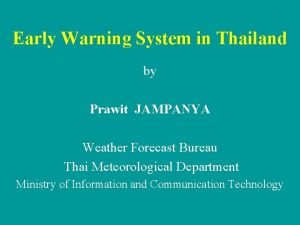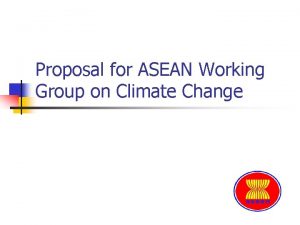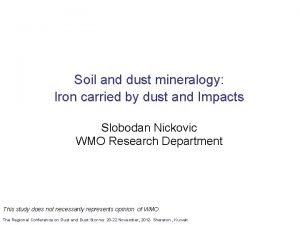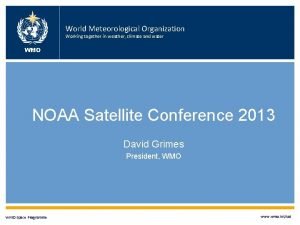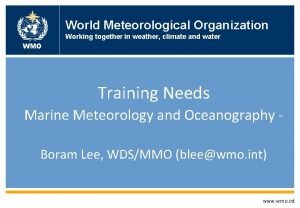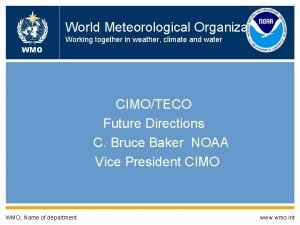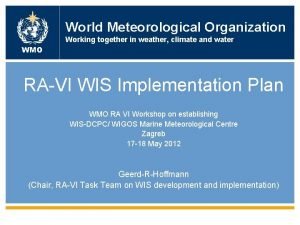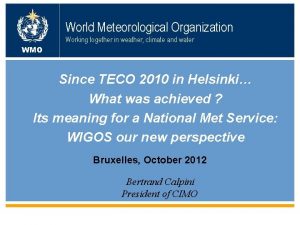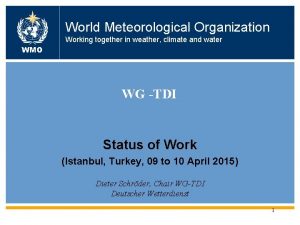World Meteorological Organization Working together in weather climate










- Slides: 10

World Meteorological Organization Working together in weather, climate and water WMO Progress of WIGOS Activities within CBS Report to ICG-WIGOS-3 (Geneva, Switzerland, 10 to 14 February 2014) Jochen Dibbern, Chair CBS OPAG IOS Deutscher Wetterdienst 1

1. Support of WIGOS implementation by CBS • CBS OPAG IOS contributes to the implementation of WIGOS, in response to guidance from ICGWIGOS and in coordination with other relevant WMO programmes and TCs. • IPET-WIFI gives priorities to GOS related aspects of the WIP, especially on Regulatory Material, standards for WIGOS metadata and Quality Management. 2

1. Support of WIGOS implementation by CBS • All the TORs of IPET-OSDE and elements of the work plan are related to WIGOS. Significant activities are updating of the WIR and developing a set of WIGOS “Principles” for Observing System Network Design (OSND). • The other Expert Teams of OPAG-IOS, ET-SBO, ET -ABO, ET-SAT and ET-SUP, contributed to the different Key Activity Areas of the WIP. 3

2. Progress on WIGOS related activities • IPET-WIFI: contributions to the ICG-WIGOS TTs • IPET-OSDE: – WIGOS “Principles” for Observing System Network Design (OSND) – RRR – updating the databases of user requirements for observations and of observing system capabilities, and the Statements of Guidance. • ET-ABO: – ABOP Strategy & Implementation Plan (A-SIP) – Regional Implementation Plans ( A-RIPs) – revised the AMDAR regulatory material for incorporation into the Manual and Guide on the GOS – worked on metdata model in cooperation with TT-WMD 4

2. Progress on WIGOS related activities • ET-SBO: – Reviewed the Manual of the GOS for surface based systems – Reviewed the draft Core Metadata Standard for TT-WMD • ET- SUP and –SAT: – Advice and support on the evolution of the space based component of the GOS – update of the RRR requirements and observing system capabilities for the space based component of the WIR 5

3. Challenges with WIGOS implementation • The RRR databases are an important component of WIGOS and have gained enormous visibility through the excellent work of Secretariat. Continuous support must be secured. • Monitoring of EGOS-IP implementation: A mechanism to promote actively implementation is needed 6

4. Intersection with other WMO and WIGOS priorities • ET-ABO investigates improving upper air coverage over the Polar Regions. • ET-ABO developed data benefits and impact material for airlines related to future impact of climate change and DRR • GFCS may generate observational user requirements that go beyond those already stated by GCOS. Therefore statements suggesting that WIGOS is “responding to the requirements of GFCS” should be made with care. 7

Draft Observing System Network Design Principles (1/2) 1. SERVING MANY APPLICATION AREAS Observing networks should be designed to meet the observational needs of many application areas within WMO and WMO co-sponsored programmes. 2. MEETING USER REQUIREMENTS Observing networks should be designed to address stated user requirements, in terms of geophysical variables to be observed and the space-time resolution, accuracy, timeliness and measurement stability needed. 3. MEETING NATIONAL, REGIONAL AND GLOBAL REQUIREMENTS Observing networks designed to meet national needs should also take into account the needs of the WMO community for applications for which requirements are regional or global. 4. MAKING OBSERVATIONAL DATA AVAILABLE Observational data from national observing networks should be made available to other WMO Members, at space-time resolutions and with a timeliness needed to meet the needs of regional and global applications. 5. PROVIDING INFORMATION SO THAT THE OBSERVATIONS CAN BE UNDERSTOOD Observing networks should be designed and operated in such a way that the details and history of instruments, their environments and operating conditions, their data processing procedures and other factors pertinent to the interpretation of the observational data (i. e. metadata) are documented and treated with the same care as the data themselves. 6. DESIGNING COST-EFFECTIVE NETWORKS Observing networks should be designed to make the most cost-effective use of available resources.

Draft Observing System Network Design Principles (2/2) 7. DESIGNING APPROPRIATELY SPACED NETWORKS Where high-level user requirements imply a need for spatial and temporal homogeneity of observations, network design should also take account of other important user requirements, such as the representativeness and usefulness of the observations. 8. DESIGNING RELIABLE, STABLE AND SUSTAINABLE NETWORKS Observing networks should be designed to be reliable, stable and sustainable. 9. DESIGNING THROUGH A TIERED APPROACH Observing network design should use a tiered structure, through which information from reference observations of high quality can be transferred to and used to improve the quality and utility of other observations. 10. ACHIEVING HOMOGENEITY AND CONSISTENCY IN OBSERVATIONAL DATA Observing networks should be designed to deliver observational data of the level of homogeneity and consistency by intended applications. 11. ACHIEVING SUSTAINABLE NETWORKS Improvements in sustained availability of observations should be promoted through the design and funding of networks that are sustainable in the long term including, where appropriate, through the transition of research systems to operational status. 12. MANAGING CHANGE The design of new observing networks and changes to existing networks should ensure adequate consistency and quality of observations across the transition from the old system to the new.

Thank you for your attention ! 10
 How does wind affect weather and climate
How does wind affect weather and climate Where do polar and tropical air masses develop
Where do polar and tropical air masses develop Satellite radar
Satellite radar March 23 world meteorological day
March 23 world meteorological day Climate change 2014 mitigation of climate change
Climate change 2014 mitigation of climate change Awgcc
Awgcc Smart work vs hard work
Smart work vs hard work Hot and cold working process
Hot and cold working process Hot working and cold working difference
Hot working and cold working difference Machining operations
Machining operations Pengerjaan panas
Pengerjaan panas


